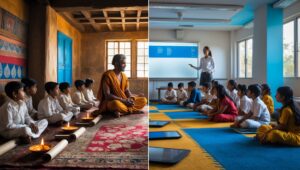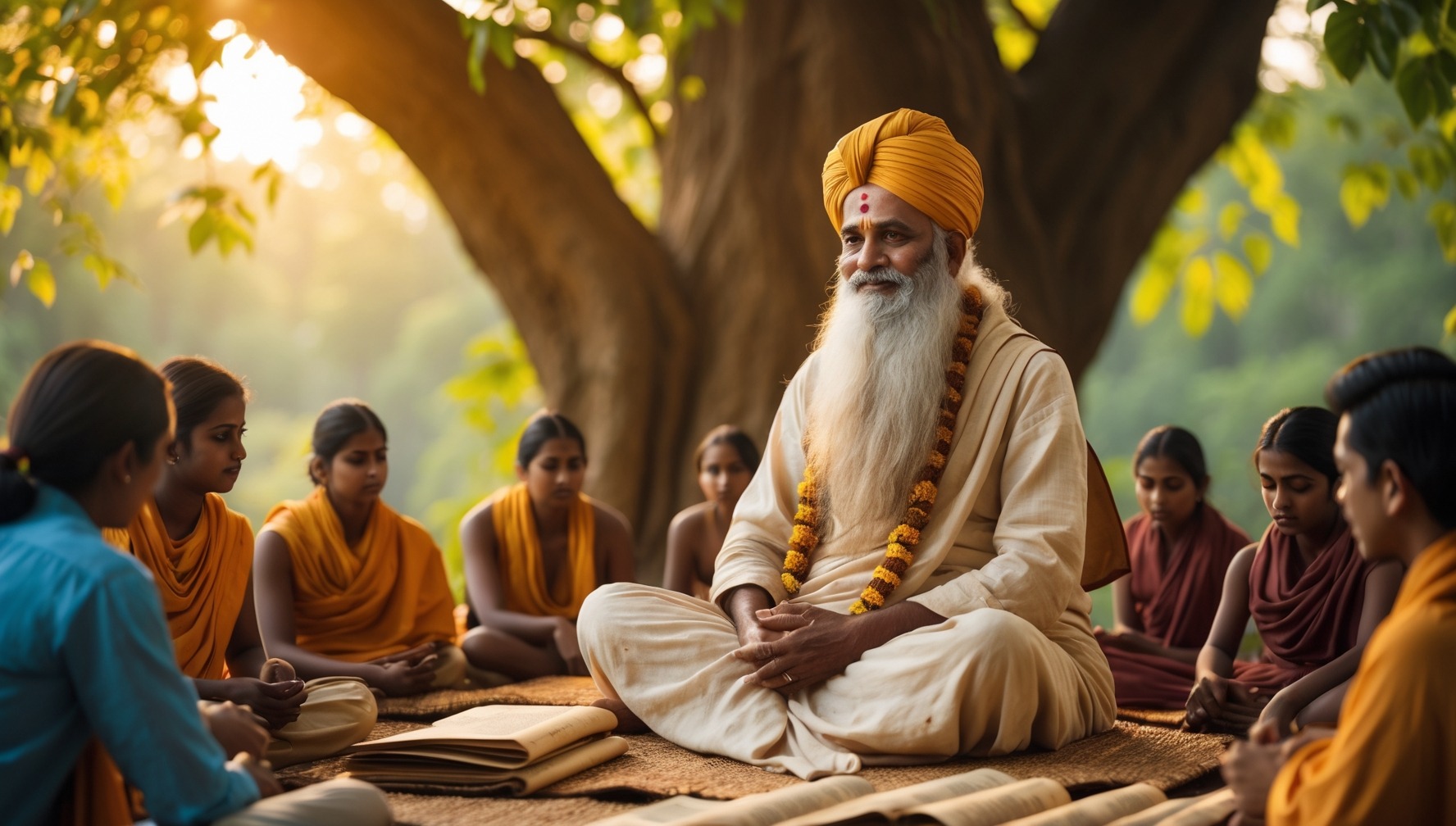The Ancient Education System in India: A Heritage of Knowledge and Holistic Development
India’s history is deeply rooted in its rich intellectual and cultural traditions, and one of its most notable achievements is the ancient education system in India. Far more than just mastering academic knowledge, this system focused on holistic development, blending moral values, spiritual growth, and practical skills. But how did this system function, and what can we, in modern times, learn from it? Let’s explore!
Understanding the Gurukula System
The Gurukula system, one of the most renowned forms of indigenous education, epitomized the ancient Indian way of learning. A Gurukula was a form of residential school where students, called shishyas, lived with their teacher, or guru. Much like today’s private institutions or boarding schools, the residential aspect encouraged a disciplined life and created a close-knit learning community.
Structure of the Gurukula
A typical Gurukula comprised:
- A guru’s residence as the center of learning.
- Students from varied backgrounds, often including rural children, princes, and even rich merchants’ sons.
- The focus on oral traditions like oral learning rather than written texts, emphasizing critical thinking and memory retention.
This approach stood in stark contrast to modern education, with its heavy reliance on textbooks and standardized assessments.
The Role of the Guru
The guru played a crucial role both as a teacher and a mentor. Beyond just transmitting academic knowledge, gurus guided students in every aspect of life—moral, spiritual, and intellectual.
Key responsibilities included:
- Imparting values of moral development and ethical values.
- Encouraging spiritual development alongside physical and intellectual growth.
- Training students in diverse fields like military science, medical treatises, and animal husbandry, depending on the area’s cultural traditions.
The guru also personalized teaching to ensure each student gained a holistic education, much like today’s concept of inclusive education.
Student Life and Responsibilities
Life at a Gurukula wasn’t just about learning; it was about building character. Students adhered to a disciplined life and were responsible for tasks like:
- Assisting with daily chores, regardless of their social status, fostering humility.
- Learning through practical application, a focus also seen in vocational training today.
- Immersing themselves in cultural and moral aspects, ensuring they became well-rounded individuals.
Methodology of Education in Gurukula
Education in ancient India was not confined to classrooms or rigid syllabi. It adopted a holistic approach that integrated practical skills with formal learning. While they studied traditional subjects, students also mastered:
- Spiritual texts such as the Vedas and Upanishads.
- Subjects like mathematics, astronomy, and technical education.
- Hands-on skills, including animal husbandry, agriculture, and even vocational education, which were essential for a self-sufficient life.
The Gurukula system also encouraged a flexible curriculum, unlike today’s rigid structures in secondary schools and government primary institutions.
The Benefits of the Gurukula System
Personalized Attention
One of the key features of the Gurukula was the individualized attention students received. Much like today’s special schools or deaf schools, education was tailored to each pupil’s abilities, ensuring everyone’s full potential was realized.
Holistic Learning
The system promoted holistic development, emphasizing a balance between intellectual, physical, and spiritual growth. For instance:
- Physical development was achieved through sports and physical labor.
- Intellectual aspects were nurtured through debates and discussions.
- Spiritual development took precedence, rooting students in their cultural and religious identity.
Moral and Ethical Education
Fostering moral values was a priority. Students didn’t just learn about their rights and duties but also imbibed lessons on empathy, discipline, and responsibility.
Ancient Education vs. Modern Education

Flexibility vs. Rigid Curricula
Compared to modern educational systems, where formal education follows standard syllabi defined by bodies like the Central Board of Secondary Education (CBSE), the Gurukula system allowed learning to flow organically. This flexibility catered to the unique strengths and weaknesses of each individual, making it a precursor to today’s inclusive approach.
Knowledge vs. Examinations
Whereas modern education tends to be examination-centric, the Gurukula system focused on acquiring a source of knowledge and understanding that would benefit students throughout their lives. The emphasis was on life skills rather than test scores.
Gurukuls in Modern Times
Despite modern education systems largely overshadowing traditional models, the ancient education system in India still influences our learning frameworks, particularly through:
- Institutions like Nalanda Mahavihara and ancient universities being historical inspirations.
- UNESCO’s recognition of traditional knowledge as a critical source of knowledge for sustainable practices and holistic learning.
- Efforts by the Indian Government to integrate moral aspects and vocational training into the National Policy on Education.
Current Adaptations of the Gurukula Model
Today, we see elements of the Gurukula system in:
- Residential schools promoting holistic education.
- Online education platforms offering flexible curricula.
- Spiritual retreats emphasizing life skills alongside academic pursuits.
Challenges and Criticisms
However, the Gurukula system wasn’t without its flaws. Access to education was often limited, with female education and opportunities for rural children notably lacking. Over time, indigenous schools faced challenges with the advent of English education and missionary schools during the 19th century.
A Lasting Legacy
The ancient education system in India continues to inspire educators and learners worldwide. The focus on holistic development, moral values, and practical learning remains relevant, even amid discussions about the digital transformation and online education.
Whether you’re exploring the future of inclusive education or revisiting traditional practices, understanding India’s educational roots provides valuable insights for shaping the educational landscape of tomorrow.
Frequently Asked Questions
Who was Chanakya, and what were his contributions to education?
Chanakya, also known as Kautilya or Vishnugupta, was a scholar, strategist, and teacher during the Maurya Empire (4th century BCE). He authored the Arthashastra, a treatise on governance, economy, and society, which serves as a significant source of knowledge and highlights the educational systems of Ancient India.
What is UNESCO’s perspective on traditional education systems?
UNESCO values traditional and indigenous education systems for their focus on sustainable living, moral aspects, and spiritual development, seeing them as integral to fostering holistic education.
